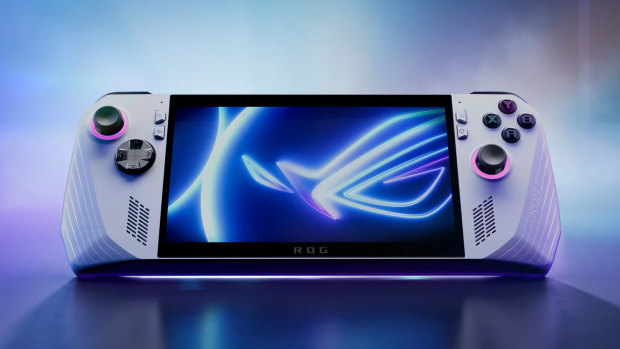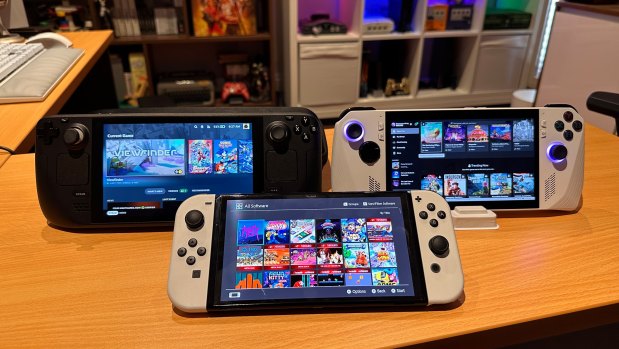
Throughout the 2010s, it was commonly thought that the smartphone would kill the market for hand-held gaming consoles. Yet while mobile gaming has flourished into a multibillion-dollar industry, it hasn’t harmed dedicated portables at all. In fact, it seems to have helped them.
As mobile gaming has accelerated the number of people regularly playing games, sales of home consoles and gaming PCs have skyrocketed, and gaming handhelds have returned to relevance in a big way. Technological advancements, driven in large part by the smartphone industry, have created powerful components that can operate in small, battery-efficient devices. And the rising interest in retro and indie gaming has fostered communities that allow niche-interest handhelds to be economically viable, alongside more mainstream devices such as ASUS’ ROG Ally portable gaming PC, which just arrived in Australia last month.

The ASUS ROG Ally is the latest dedicated hand-held gaming device, able to play just about any game that works on Windows.
Players, as well as console makers, have realised that smartphones and dedicated consoles are good at different things, even if there’s a significant crossover in functionality. Smartphones will always be generalised devices for example, while dedicated game machines can have unique inputs and a variety of games made specifically for them. There’s also something to be said for keeping your leisure devices separate from your productivity machines.
The hand-held renaissance arguably began with the Nintendo Switch in 2017. The Japanese gaming giant had maintained separate home consoles and hand-held systems ever since the Super Nintendo and Game Boy more than 30 years ago. But with development costs rising, and the threat of mobile gaming eating into the business, spreading efforts across a number of devices made less sense. Its competitor and compatriot Sony abandoned its portable consoles entirely, but Nintendo merged its development staff into a single team and devised a console that could do both; play games on the go, or plug into a TV.
The time was right technologically speaking, as Nvidia’s line of Tegra chips — originally made for phones and tablets — could power portable games for hours as well as create Full HD graphics on the big screen. And the Switch seemed to hit at the right time for players, too. It’s become practically the only mainstream games system in Japan, and worldwide has been more successful than any of Nintendo’s home consoles. With the standard $470 Switch, the $330 portable-only Switch Lite and the $540 OLED model combined, it has sold more than 125 million units.

Valve’s Steam Deck (left) lets you take games from its online store with you, while the Nintendo Switch (front) is by far the most popular currently-sold video games machine.Credit: Tim Biggs
While Nintendo was releasing the Switch, a portable machine was also being developed at Valve, the US company behind ubiquitous PC gaming storefront Steam. The Steam Deck is essentially a powerful Linux laptop with game controls built in, but its strength is how it essentially consolises the complicated and potentially overwhelming PC gaming landscape. Valve constantly enhances its Proton software, which lets games designed for Windows run smoothly on Linux, and assesses every one of the thousands of games on the Steam store to gives each one of four compatibility ratings, so you know a game will work before you buy it.
It also has a range of inputs, including touchpads and a gyroscope — paired with a clever system that lets you copy controller settings from other players around the world — which makes PC games from high-end releases like Elden Ring to indies like Dave the Diver very accessible. Battery life can be a bother, coming in as low as 90 minutes in some cases. But there is a wealth of options to let you trade performance for more juice. Valve does not yet officially sell the Steam Deck in Australia. In the US, it starts at $US400 ($590).
Australians aren’t completely left out though, as ASUS’ aforementioned ROG Ally is an impressive alternative that gives a window into where portable games may be headed, even if it comes with a few caveats. With extreme processing power, customisable lighting and an incredible screen that can handle Full HD and high refresh rates, it’s like a desktop PC gaming system squished into a hand-held. As with the Steam Deck, a key selling point here is that you have access to decades of PC games plus brand new releases. And as Sony and Microsoft move away from a console focus to a services focus you increasingly get Xbox and PlayStation games on PC as well, like Halo and God of War.



























